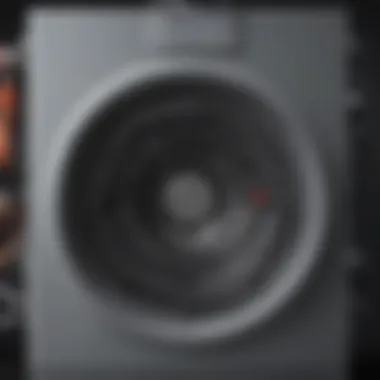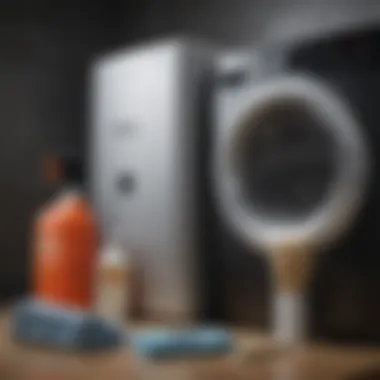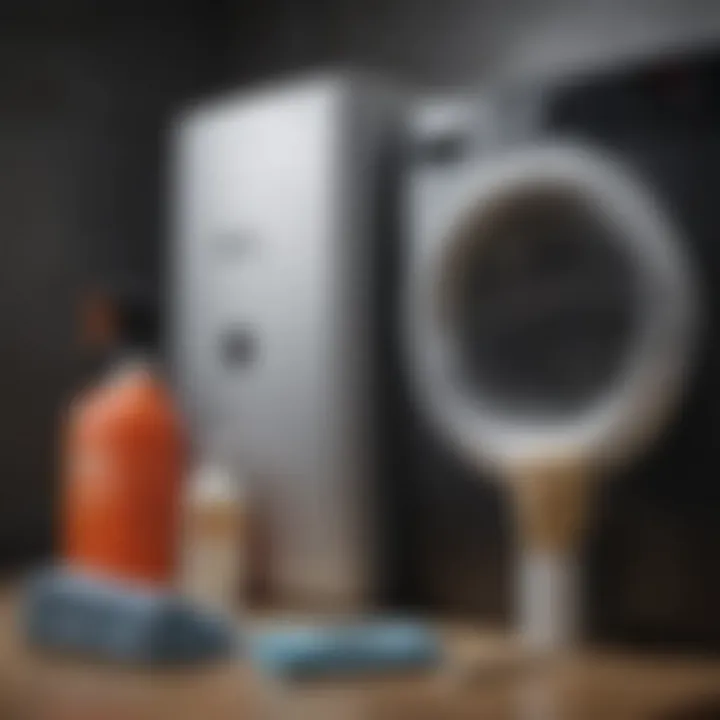Comprehensive Guide to Air Dryer Cleaning


Intro
The functionality of air dryers in both residential and commercial environments is often underestimated. However, their role in maintaining air quality and performance is crucial. As air dryers collect moisture and particulates, keeping them clean is essential for their longevity and efficiency. This guide delves into the various methods and practices for cleaning air dryers, ensuring they operate effectively over time.
Proper cleaning not only enhances efficiency but also extends the lifespan of these appliances. Neglecting maintenance can lead to decreased performance, higher energy costs, and even premature failures. Understanding the intricacies of air dryer cleaning is vital for anyone looking to optimize their use.
Why Cleaning Matters
Cleaning air dryers should not just be a routine task; it is an integral part of efficient air management. Regular maintenance prevents dirt and moisture accumulation, which could lead to extensive repairs or replacements.
Key Points Discussed
- Types of Air Dryers: Understanding the different types, such as refrigerant and desiccant dryers, can help in choosing the right cleaning approach and frequency.
- Cleaning Processes: Step-by-step cleaning guidance ensures that the process is systematic, reducing potential damage during maintenance.
- Preventative Maintenance: Strategies for preventative care help in minimizing disruptions and maintaining optimal performance.
Maintaining awareness of these factors will benefit users significantly. The aim here is to equip readers with thorough knowledge that elevates the performance and durability of air dryers.
Understanding Air Dryers
Air dryers are essential devices in both residential and industrial settings. They serve a critical function by removing moisture from compressed air systems. This moisture must be controlled to prevent various problems, including corrosion, mold growth, and loss of equipment efficiency. Understanding air dryers involves recognizing their types, functions, and the significance of their operation.
Types of Air Dryers
Air dryers can be broadly categorized into several types, each with unique operating principles and applications. The main types are:
- Desiccant Air Dryers: These dryers use a desiccant material to absorb moisture from the air. Typically, they operate in cycles where one unit adsorbs moisture while another is regenerated.
- Refrigerated Air Dryers: This type cools the compressed air, causing moisture to condense and separate. These dryers are cost-effective and often used in many industrial applications.
- Membrane Air Dryers: Membrane dryers function by filtering out moisture through a membrane material. They are generally compact and suitable for smaller systems.
- Cyclone Separators: Not exactly dryers, these remove bulk moisture from the air using centrifugal force. They are often used in conjunction with other types of dryers.
Recognizing the differences among these types allows users to select the best option for their specific requirements.
The Role of Air Dryers in Homes and Industries
Air dryers play an important role in ensuring the quality of compressed air. In homes, they can be used to power pneumatic tools or maintain air quality in HVAC systems. Their function helps protect against water damage and enhances indoor air quality.
In industrial settings, air dryers are vital to the operation of machinery. They help maintain equipment by preventing rust and damage caused by moisture. This improves equipment lifespan, reducing failure rates and costly downtimes.
Regular maintenance, including cleaning air dryers, is essential to maintaining their efficiency and performance.
Moreover, the efficiency of air dryers directly impacts overall energy consumption. Well-maintained dryers work more effectively, leading to lower energy costs for businesses and homeowners alike. Understanding the nuances of air dryers thus enables users to optimize their performance, contributing to both economic and environmental sustainability.
Importance of Regular Air Dryer Cleaning
The effectiveness of an air dryer hinges on regular cleaning practices. Without proper maintenance, performance can decline, leading to potential issues in both residential and industrial settings. Regular air dryer cleaning does not only enhance operational efficiency but also mitigates various risks that can arise from neglect. Ensuring that these systems are clean allows for better air quality and consistent performance.
Preventing Airborne Contaminants
Airborne contaminants can cause significant harm, especially in environments that rely on clean air. Dust, mold, and other particles accumulate in air dryers over time. If these contaminants are not addressed through regular cleaning, they can enter home or industrial space through the air system. For instance, a study showed that unclean air filters allow up to 30% more contaminant entry than clean ones. Maintaining cleanliness prevents these particles from being release into the surrounding areas, creating a healthier environment.
Enhancing Dryer Efficiency
An efficiently running air dryer leads to energy savings and improved performance. When dirt builds up, it forces the dryer to work harder, which consumes more energy and results in decreased efficiency. For example, properly maintained heat exchangers can operate up to 60% more efficiently than dirty ones. Regular cleaning can maintain airflow and optimal temperature regulation, allowing the appliance to operate at its designed efficiency. In the long run, this practice can significantly lower operating costs.
Extending Equipment Lifespan


Neglecting air dryer maintenance can lead to wear and tear on various components. Accumulated dirt and contaminants can cause parts to fail prematurely, which requires costly repairs or replacements. For instance, filters that are not regularly changed can become clogged, which puts extra pressure on motors and other components. By implementing a cleaning schedule, users can effectively extend the lifespan of their equipment, protecting their investment and avoiding the inconvenience of unexpected breakdowns.
Step-by-Step Air Dryer Cleaning Process
Cleaning an air dryer is crucial for maintaining its efficiency and longevity. A systematic approach simplifies the task and ensures no vital component is overlooked.
Gathering Necessary Tools and Materials
Before starting, gather all necessary tools and materials. This will save time and make the process smoother. Common items needed include:
- Screwdrivers for disassembly
- Clean cloths and brushes
- Vacuum cleaner with a hose attachment
- Mild detergent or cleaning solution
- Replacement filters if needed
Having these tools ready helps to prevent interruptions during cleaning. It ensures every step can proceed efficiently.
Turning Off and Disconnecting the Unit
Safety is paramount. Turn off the air dryer using its main power switch. Unplug it from the power source immediately after. This prevents any electrical hazards and ensures your safety while cleaning. It also stops any operational noise, helping you concentrate better on the task ahead.
Disassembling the Dryer Components
Once disconnected, gently disassemble the dryer. Refer to the user manual for specific instructions if available. Start with the outer casing, removing screws and clips as necessary. Keep the screws in a safe place to avoid losing them. This step will reveal the interior components that require cleaning.
Cleaning Specific Parts
Now focus on cleaning individual components effectively.
Filters
The filters are the first line of defense against contaminants. They collect dust, lint, and other particles during operation. A clean filter improves airflow and efficiency. Most filters can be easily removed and cleaned or replaced. Be sure to check your manual for instructions on the type of filter used. The right maintenance can significantly enhance their performance and longevity.
Heat Exchanger
The heat exchanger is vital for regulating temperature. Dust accumulation can impede its function, leading to overheating. A clean heat exchanger operates more effectively, reducing energy consumption. When cleaning this part, use a soft brush to loosen dust before vacuuming. Careful handling is necessary to avoid damaging any fins or coils.
Housing
The housing protects internal components. It can also gather dust and grime over time. Cleaning the housing involves wiping down with a damp cloth, ensuring no residue is left behind. Keeping the housing clean helps maintain an appealing appearance and prevents dirt from entering the dryer.
Reassembling the Air Dryer
Once all components are clean, it’s time to reassemble the dryer. Follow the steps in reverse order. Ensure all screws are tightened and that no parts are left loose. Proper reassembly is crucial to ensure the dryer operates correctly. Take your time and follow the instructions carefully.
Testing for Proper Functionality
Before considering the job complete, test the air dryer after reassembly. Plug the unit back in and turn it on. Monitor for any unusual sounds or vibrations. Additionally, check the airflow. A properly cleaned and assembled dryer should run smoothly without issues. Ensuring functionality at this stage guarantees that your efforts in cleaning have paid off.
Common Challenges in Air Dryer Cleaning
Cleaning air dryers is essential for maintaining their efficiency and prolonging their lifespan. However, several challenges can arise during the cleaning process. These challenges can deter effective maintenance and may even inadvertently lead to further complications if not addressed properly. Understanding these common challenges can help users prepare better and take proactive steps to ensure a successful cleaning process.
Identifying Deep-Seated Dirt and Contaminants


One of the significant challenges in cleaning air dryers is identifying deep-seated dirt and contaminants. Over time, air dryers accumulate dust, lint, and other particles in areas that are not accessible during routine cleaning.
Often, users under-appreciate the accumulation that builds up in hidden areas, such as inside ducts or behind filters. Spot cleaning does not suffice in these instances. Owners must take extra steps to locate and remove these stubborn contaminants.
Regular and thorough inspections are beneficial in pinpointing these areas. Tools like vacuum attachments and brushes can assist in reaching difficult spots. Failing to remove these hidden accumulations can result in reduced airflow and increased operational energy costs.
Access Issues with Certain Models
Accessing the internal components of air dryers can present its own set of challenges. Different models vary in design, which affects how easily parts can be reached for cleaning.
Some air dryers have tightly sealed designs, making disassembly complicated and time-consuming. This can lead to frustration and a sense of helplessness. Users may abandon the task, leaving the dryer inadequately cleaned.
To remedy this, it's advisable to consult the manufacturer’s manual for guidance on disassembly. Online forums and community discussions on Reddit can also provide valuable insights from owners of the same model. Proper understanding of your specific air dryer model can streamline the cleaning process and help in avoiding damage during disassembly.
The Risks of Over-Cleaning
While cleaning is vital, over-cleaning presents another challenge that many may overlook. It may seem counterintuitive, but excessive cleaning can cause damage to components. For instance, using too much force or harsh chemicals might wear down the protective coatings on certain parts, leading to premature wear.
Moreover, focusing too much on cleaning every single part may lead to neglecting important maintenance tasks. Understanding the right balance between cleanliness and operational integrity is crucial in air dryer maintenance. Establishing a regular, moderate cleaning schedule aligns with the goal of efficiency without causing harm.
Professional Air Dryer Cleaning Services
Professional air dryer cleaning services play a crucial role in maintaining the efficiency and longevity of air dryers. These services offer specialized knowledge and experience that go beyond what average users can achieve with home cleaning methods. A comprehensive understanding of the inner workings of air dryers allows professionals to identify hidden issues and clean components effectively. This not only improves the operational efficiency but also prevents the occurrence of larger problems in the future.
When to Consider Professional Help
There are several scenarios where it becomes necessary to seek professional assistance for air dryer cleaning:
- Significant Accumulation of Dirt: If the dryer is showing signs of substantial dirt buildup that is not easily removable with standard cleaning practices, professional equipment can provide a thorough cleanse.
- Unusual Noises or Performance Issues: Strange sounds or decreased performance often signal underlying mechanical problems. Professionals can diagnose these issues during a cleaning session.
- Complex Models: For air dryers with complicated designs or components that require special tools for disassembly, hiring experts eliminates the risk of damage.
- Time Efficiency: For busy professionals or businesses, using a service saves time. It allows users to focus on their main tasks while ensuring the dryer receives the care it needs.
What to Expect from a Professional Service
When opting for a professional air dryer cleaning service, clients should be aware of several key aspects:
- Thorough Assessment: Professionals will first conduct a detailed assessment of the air dryer to identify areas requiring special attention. This step may include checking filters, hoses, and the overall structure of the unit.
- Specialized Cleaning Techniques: Technicians implement industry-specific cleaning methods. Expect the use of high-powered vacuums and appropriate cleaning agents that are safe for the unit yet effective against contaminants.
- Comprehensive Reporting: Post-cleaning, a detailed report on the dryer’s condition may be provided. This often includes recommendations for future cleaning and maintenance schedules based on observed wear and performance.
"Regular professional services not only clean but also optimize your equipment's efficiency, extending lifetime."
- Preventative Maintenance Tips: Professionals typically offer advice on routine maintenance, enabling users to improve their care approaches moving forward.
Preventative Maintenance for Air Dryers
Preventative maintenance is critical for ensuring that air dryers function effectively and have prolonged lifespan. Neglecting regular upkeep can lead to reduced efficiency, increased energy consumption, and potentially costly repairs. By engaging in consistent maintenance routines, homeowners and businesses can avoid unexpected breakdowns, improve air quality, and ultimately save money over time.
Creating a Cleaning Schedule
Establishing a cleaning schedule is fundamental in maintaining air dryers. Regular cleaning helps in removing dust, dirt, and debris that accumulate inside the unit. A practical approach is to integrate a cleaning timetable that aligns with seasonal changes or operational demands. For instance, check and clean filters monthly, as these components are susceptible to clogging.
Additionally, consider performing a thorough inspection and cleaning of the entire unit every six months. This can prevent major issues arising from neglected components. A simple checklist can be useful:
- Inspect filters and clean or replace as necessary
- Check heat exchangers for dust buildup
- Examine hoses and connections for wear
- Assess the housing for any signs of damage or rust


Regularly sticking to this schedule will lead to better airflow and efficiency.
Regular Inspection of Components
Regular inspections of air dryer components are essential to maintain optimal performance. Each part has a specific function that contributes to the overall efficiency of the dryer. Key components to inspect include:
- Filters: Dirty filters restrict airflow and increase energy use.
- Heat Exchanger: This component needs to be checked for any accumulation of dirt which can affect performance.
- Hoses and Connections: Ensure there are no leaks or cracks to prevent loss of air pressure.
Conducting these inspections will allow for timely interventions. Early detection of problems can prevent expensive repairs later.
Controlling Environmental Factors
The environment in which the air dryer operates plays a direct role in its effectiveness. External factors such as humidity, temperature, and dust levels can impact performance. To ensure optimal functioning, control these environmental factors as much as possible.
For instance, placing the air dryer in a well-ventilated, dry area can minimize dust accumulation. Maintaining appropriate room temperatures can also prevent moisture from condensing within the unit, which can lead to mold or mildew.
"Controlling these factors is an investment in your air dryer's efficiency and lifespan."
In summary, the integration of a solid preventative maintenance strategy can significantly impact the performance and durability of air dryers. Establishing regular cleaning schedules, inspecting key components, and controlling environmental conditions are all essential practices to maximize efficiency and longevity.
Environmental Impact of Air Dryers
The environmental impact of air dryers is an important aspect that often gets overlooked in discussions about their functionality and efficacy. Air dryers do not only play a critical role in maintaining optimal conditions for various appliances and processes, but they also have implications for energy consumption and sustainability practices. Understanding these elements is vital not just for the proper maintenance of air dryers but also for ensuring they align with broader environmental considerations.
Energy Consumption Considerations
Air dryers, when operated, consume a significant amount of energy. This consumption affects both operational costs and the overall carbon footprint. Efficient air dryers are designed with energy-saving technologies, which can lead to reduced electricity bills and a lower environmental impact. For instance, dryers fitted with variable speed drives can adjust their operation according to demand, rather than running at full capacity at all times.
It's essential to regularly evaluate the energy efficiency ratings of air dryers. Energy Star certified products often ensure optimal performance with less energy usage. Allowing users to make informed decisions can contribute significantly to energy conservation. Monitoring energy consumption periodically can aid in identifying inefficiencies that may require remedial action. Here are some simple strategies to reduce energy consumption:
- Invest in Energy Efficient Models: Newer models often come with improved technologies.
- Regular Maintenance: Keeping the air dryer clean helps it work more efficiently.
- Optimize Usage: Run air dryers during off-peak hours when energy may be cheaper.
Sustainability Practices for Air Dryers
Incorporating sustainability practices when using air dryers can greatly mitigate their negative environmental effects. These practices not only focus on reducing energy consumption but also promote recycling and the use of eco-friendly materials. Some best practices include:
- Proper Disposal and Recycling: Ensure that any old air dryer is recycled or disposed of according to local regulations. Many components can often be recycled, preventing waste.
- Use of Green Materials: Companies that manufacture air dryers are increasingly exploring eco-friendly materials. Choosing such products can contribute to a sustainable lifecycle.
- Integrating Renewable Energy Sources: For installations where possible, linking air dryers to solar panels or other renewable sources can significantly reduce their environmental footprint.
Adopting sustainable practices is not just beneficial for the environment but can also enhance the overall performance and longevity of air dryers.
By recognizing and addressing the environmental impact of air dryers, users can ensure that they contribute positively to the planet while benefiting from efficient and reliable operation.
Closure
Cleaning air dryers is essential for maintaining their performance and longevity. In this article, we have presented various aspects of air dryer cleaning. It is not just a maintenance task, but a necessity that impacts efficiency, safety, and operational costs.
Summarizing the Importance of Cleaning
Regular cleaning of air dryers prevents the build-up of dirt and contaminants. This aspect is vital as it directly influences the air quality in homes and industries. Dirty filters or components can lead to operational inefficiencies. Thus, regular cleaning ensures that the air dryer operates at its optimal level. Moreover, it can significantly reduce the risk of equipment failure. Not only does this protect the investment made in these systems, but it also extends the lifespan of these machines.
"Regular maintenance and cleaning increase the efficiency and reliability of air drying systems."
Future Considerations in Air Dryer Maintenance
As technology continues to evolve, it is important to adapt maintenance practices accordingly. Future air dryers may incorporate advanced features that enhance their performance. This change may also affect cleaning methods. It will be essential to stay updated with the latest maintenance recommendations from manufacturers. Additionally, considering environmental aspects, such as energy efficiency, will play a crucial role in choosing air dryer models in the future.
The focus should not only be on immediate performance but also on sustainability. This approach will ensure that air dryers are both effective in function and environmentally friendly. Regular training and education on best practices for maintenance can also benefit users significantly.







